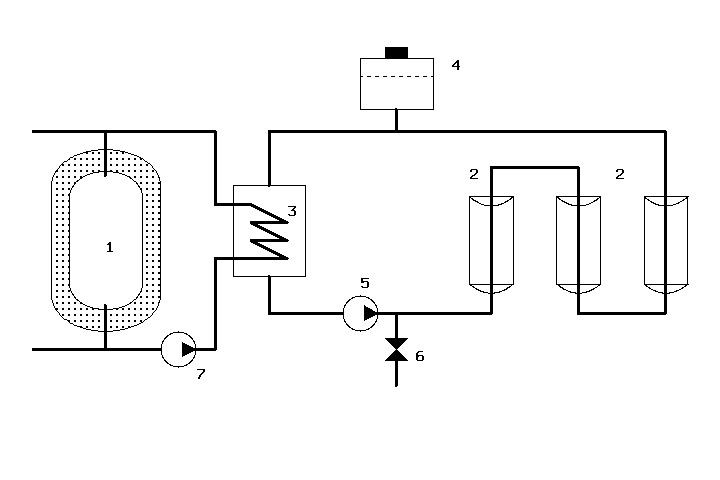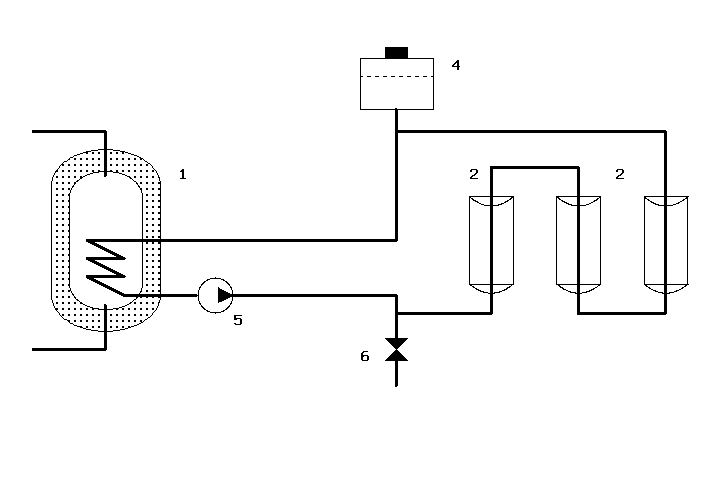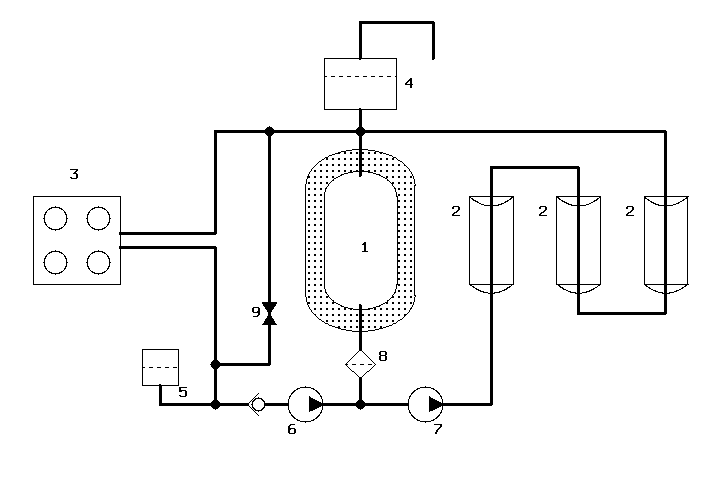Low-temperature water version
This is basically a solar water heater and/or space heater, plus possibly the capability of driving absorption air conditioners.
The system needs a hot water tank to store the heat. This tank can either be an electricity + solar dual heating tank, or an ordinary electric hot water tank. The schematics of the two options are shown below. It is the classical setup of many non-concentrated water heaters.


In these figures, 1 is the hot water tank, 2 is the collector array, 3 is the heat exchanger in case where the hot water tank is electric only, 4 is the expansion tank of the non-freezing liquid circulating in the collectors, 5 is the pump for the collector circulation, 6 is the purge valve, 7 is the pump of normal water. In an easy setup of dual energy (solar plus electricity) water heating system, the electric heating thermostat can be adjusted to act at a very low temperature, for example 45°C, while the solar collecting temperature limit can be set to quite high, such as 75°C. In this way, electricity consumption will be automatically cut off as long as solar heating is available, because the temperature in the water tank will be above the acting temperature of the electric heating thermostat.
Now that solar energy supplies really cheap hot water, one can branch many appliances to the hot water supply, such as clothes washer and dish washer. In doing so, hot water will be "wasted" a little bit during machine cycles where cold water is usually used, but this is still much less expensive than to use electricity to heat cold water. This will also greatly accelerate washing time.
High temperature oil version
This version uses heat transfer oil to extract solar thermal energy with high temperature, and store the thermal energy in a thermal storage tank. The schematics is as below.

Here a collecting pump (7) pumps heat transfer oil through the solar collectors (2). Oil heated up by the collectors enters into the thermal storage tank (1) from the hot end at the top. Oil circulation goes out from the storage tank from the lower outlet, and passes through an oil filter (8).
The left side of the schematics is the heat consumption circuit, where the consumption pump (6) pumps oil into the lower outlet of the storage tank. Oil circulation out of the upper outlet of the storage tank is fed to home ustensils (3) such as cooker, water heating heat exchanger, electricity generating module, etc. A buffer tank (5) is added in the circuitry to buffer the abrupt variations of flux in the consumption circuit, and a thermally controlled valve (9) controls a short circuit which reduces the temperature variation of oil going into the storage tank.
Finally, an expansion tank (4) compensates the thermal expansion of heat transfer oil.
Theoretically, the maximal oil temperature can go up to 350°C. However, local authorities will probably put limitations on this temperature, as a too high oil temperature will increase the risk of fire in case of pipe rupture.
This version can meet all the household energy need. In the kitchen, the thermal oil of about 250°C is enough to supply heat for every cooking mode. Moreover, the circulation of hot thermal oil has a very high power capacity, enough to supply instantaneous hot/boiling water or generate steam for example. The electricity generating module can generate electricity round the clock, drawing slowly energy from the thermal storage tank. At the same time, the cooling water of the electricity generating module heats up water in a hot water tank. During the night, the surplus electricity can be used to charge a vehicle to be used the next day to drive to work.
The capacity of the thermal storage tank will be exhausted during a prolonged period of bad weather. In this case, chemical fuel (renewable fuel) can be used to heat up the system.
Now, such a system will be much more economic to the user than buying grid electricity. If there is a black out, the solar household will not be affected.